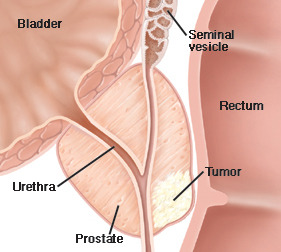Cancer occurs when cells in the body begin changing and multiplying out of control. These cells can form lumps of tissue called tumors. Cancer that starts in the prostate is called prostate cancer. Cancer can grow and spread beyond the prostate, threatening health and life.
Understanding the Prostate
The prostate is a gland about the size and shape of a walnut. It surrounds the upper  part of the urethra in men, the tube that carries urine from the bladder. The prostate produces most of the semen in which sperm travel. During orgasm, semen exits the body through the urethra.
part of the urethra in men, the tube that carries urine from the bladder. The prostate produces most of the semen in which sperm travel. During orgasm, semen exits the body through the urethra.
When Prostate Cancer Forms
As a man ages, his prostate may change. Inside a changing prostate, groups of cells may form tumors or other growths. Some may be benign (not cancerous), but they may still cause symptoms. Others may be cancerous.
- Noncancerous growths. As a man ages, the prostate may grow larger. This condition is called benign prostatic hyperplasia (BPH). Extra prostate tissue often squeezes the urethra, causing symptoms such as difficulty urinating. But BPH does NOT lead to cancer.
- Atypical cells (prostatic intraepithelial neoplasia, or PIN). Some cells don’t appear normal, but they are not cancer. These cells may indicate that cancer is present or is likely to form.
- Cancer. Abnormal cells form a tumor (a lump of cells that grow uncontrolled). Cancer may or may not produce symptoms. Some tumors can be felt during a physical exam, others can’t.
- Cancer spread. Prostate cancer may spread to nearby organs. In some cases, the cancer spreads further, to bones or organs in distant parts of the body. This is called metastasis.
Diagnosing Prostate Cancer
Prostate cancer may not cause symptoms at first. Urinary problems often are not a sign of cancer, but of another condition. To find out if you have prostate cancer, your doctor must examine you and order tests. Tests help confirm a diagnosis of cancer. They also help give more information about a cancerous tumor. Tests include:
- Prostate specific antigen (PSA) testing: PSA is a chemical made by prostate tissue. The PSA level (amount of PSA in the blood) is tested to evaluate a man’s risk for prostate cancer. In general, a high or rising PSA level may mean an increased cancer risk. PSA testing is also used to evaluate the success of cancer treatments.
- Core needle biopsy: This test involves taking tissue samples from the prostate to provide more information about cancer cells. During the test, a small probe is inserted into the rectum as you lie on your side. This lets an image of your prostate be seen on a video monitor. With this image as a guide, the doctor uses a thin needle to remove tiny tissue samples from the prostate. You are given medications so you don’t feel pain during the test.
